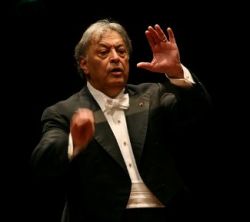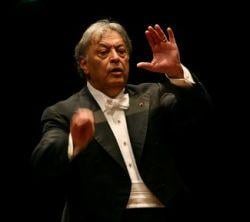
What other touring orchestra posts its country's flag on stage when performing internationally? Israel's nationalistic pride is well known, and the Israel Philharmonic Orchestra (IPO) is a particularly special source of honor for Israelis. The orchestra and its esteemed conductor Zubin Mehta (who is Indian and not Jewish, yet has been embraced by the Israeli public) have an aura of heroic resilience, having performed from the front lines during Israel's many wars.
Those who remember the outburst of musical responses after 9/11 will appreciate the healing and unifying power that music can provide in times of national duress, and will understand the important place that the Israel Philharmonic holds in the hearts and minds of Israelis. The orchestra has its share of admirers abroad as well, including organizations such as the American Friends of the Israel Philharmonic Orchestra, which supports its many tours.
The IPO and Mehta are celebrating their 50th season together with an eight-concert U.S. tour, with stops in Florida, New York, Seattle, Los Angeles, and two performances in San Francisco. Sunday night's concert featured Haydn's "Miracle" Symphony (No. 96) and Mahler's Fifth Symphony; Monday night's concert featured Beethoven's Leonore Overture No. 3, Webern's Passacaglia and Six Pieces for Orchestra, and Schubert's Ninth Symphony, the "Great" C major. (If, after this exhausting schedule, the members of the IPO seemed a bit exhausted, they can be forgiven.)
Mehta walks on stage in an unhurried andante, gazing pensively at the audience, his step full of grandeur, his slight smile confident and experienced, yet worn-out and condescending (as a classic old-fashioned maestro's should be!) from thousands of performances (over 1,600 with the IPO, and hundreds more as the director of the New York Philharmonic, and hundreds more with the world's other top-tier orchestras). It's hard to imagine a more practiced and decorated veteran of orchestral music. Yet once the music starts, this façade melts away, and honest emotion is freely displayed for the world to enjoy.
Mehta's interpretation of the Beethoven overture focused on dynamics and clarity. For this Classical-era piece, it was crisp accuracy that made for an exhilarating performance, rather than raw passion. The orchestra achieved astonishing levels of softness, which allowed the woodwind soloists (especially that speedy flute solo in the recapitulation) to play their brilliant passages softly — an effect that is only made more exciting when the orchestra finally plays forte.
The Abstract Dream
The amazing dynamic range was expanded to further extremes in Webern's miniatures. Barely audible sighs and pizzicato, hidden amidst carefully choreographed hushed musical chaos, contrasted with deafening percussion storms. There is something epic and biblical — as if from the days of the Second Temple in Jerusalem — in seeing and hearing Jews with long beards, sidelocks, and skull caps diligently carrying out Webern's exacting score with devout precision (the Psalms are full of mentions of percussive instruments at the temple).
Webern's percussion battery is exhilarating. Tubular bells visibly shook from ecstatic hammer hits; a bass drum was caressed (eliciting whispers), then whacked and beaten (eliciting sounds genuinely dangerous to the ear); a tam-tam shimmered; and cymbal strikes were turned facing forward for maximum sonic and visual effect. This is to mention just a few bits of the unending diversity of sounds generated by the orchestra, faithfully following Webern's score. Each effect is fleeting in Webern — the abstract dream passes quickly, as if forgotten.
After intermission, the audience was greeted with a bizarre seating change. Instead of their customary position behind the strings, the four pairs of woodwinds sat in a circle at the front of the orchestra. Whether Mehta has found musicological support for this or whether he simply likes the wind parts in this work, principal oboist Bruce Weinstein made the most of the golden opportunity. As he sat in the concertmaster position, his oboe became an extension of Mehta's baton: just as unclear for rhythmic direction, yet just as impassioned. The strings seemed visibly upset about this arrangement, darting glances to each other throughout the second half. With ears so finely attuned to picking up a colleague's sound from one direction, it must be difficult suddenly to deal with that sound coming from another.
The cellos and violas were seriously shortchanged by this arrangement, as were the second violins, sitting with their backs to the audience across from the firsts. On the plus side, gems in the woodwind part writing were revealed with extraordinary clarity, as if a curtain had been lifted from in front of them. The symphony almost felt like a sinfonia concertante for an octet of winds. The "trio" section of the Scherzo, a spot in the symphonic structure traditionally reserved for the woodwinds to show off, shone with special brightness. Yet the strings managed to plow from behind in the finale with virtuosic playing in exquisite unison, providing a shimmering backdrop for the folksy melodies in the winds.
The whole concert was one giant crescendo, with its culmination in the encore (a pity that these beloved postconcert surprises are so often tossed off as light fare to pacify the audience after an epic performance). Mehta addressed the audience and dedicated the Schubert to a good friend he once had in San Francisco (here he choked and genuinely teared up), Professor Josef Krips (1902-1974), director of the San Francisco Symphony (1963-1970). In the spirit of Krips' and Schubert's Viennese connection, Mehta chose the Overture to Die Fledermaus by Johann Strauss. Inspired by Mehta's passionate dedication, the orchestra outdid themselves with passion of their own. The "Viennese-waltz-delay" was in full force, and perfectly coordinated by the huge but nimble orchestra. Mehta had to grab the concertmaster's hand and lead the orchestra offstage, while the audience continued to clap and cheer.

